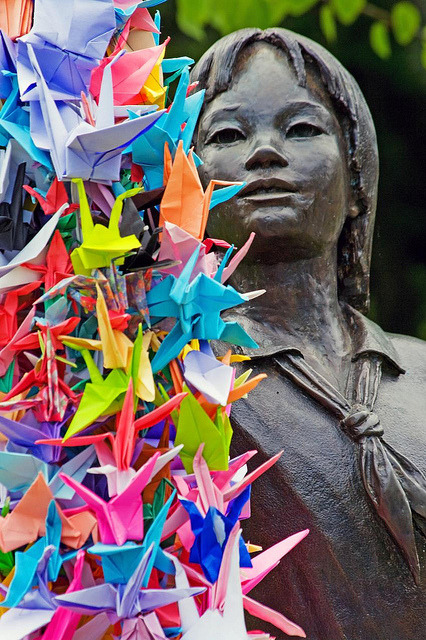Sadako Sasaki, with two years old, was at home when the explosion of the
atomic bomb that was dropped on Hiroshima in 1945 blew her out of the window,
which she somehow miraculously survived. But when she was eleven, signs of
leukaemia started to show (swelling on her neck and behind her ears, as well as
purple spots on her legs) caused by the radiation exposure, and she had to be
hospitalized in February of 1955 after being told she only had one year left to
live.
On August of that same year Chizuko Hamamoto, Sadako's best friend, went
to the hospital to visit her. She folded an origami crane on a golden colour
piece of paper and told her about an ancient Japanese legend that promises that
a crane, or the gods, depending on the version of the legend, will grant a wish
to anyone who manages to fold a hundred paper cranes. Sadako decided to try it,
though she knew she wouldn't ever get cured. She wanted to wish that nobody
else ever had to find themselves in her situation.
Though she had plenty of free time in the hospital, she couldn't find
enough paper. She used medicine wrappings, paper from get-well presents and the
pieces her friend bought from school for her. She passed away at the young age
of twelve, on the morning of October 25 in 1995.
Whether she managed to finish them or not isn't known. The most popular
version is that she couldn't complete the 1000 cranes and died with “only”
having done 644. However, the Hiroshima Peace Memorial Museum states that she
did manage.
After her death, Sadako's friends and schoolmates raised funds and built
a memorial to her and all the children who had died, or were about to die,
because of the effects of the atomic bomb. Now there is also a statue of Sadako
holding a golden crane at the Hiroshima Peace Memorial Park.
Sadako's older brother, Masahiro Sasaki, has become a peace activist.
In Japan, the crane is considered a holy creature, such as dragons or
tortoises, and it is said to live for a thousand years, hence why 1000 cranes
are made in the legend. Some say that all of the cranes must be completed
within a year and must all be made by the person who wants to make the wish at
the end, and it doesn't count if they are given to somebody else. However, it
is a popular gift for special friends and family.
The 1000 origami cranes receive the name of Senbazuru (千羽鶴), with sen
meaning 'a thousand' and tsuru
meaning ‘paper crane’. A thousand paper cranes are traditionally given by the
father as a gift at a wedding, who wishes for "a thousand years of
happiness and prosperity" to the couple. Hanging them in one's house is
considered to be a powerful lucky charm.
 |
| How to fold a paper crane |


No comments:
Post a Comment